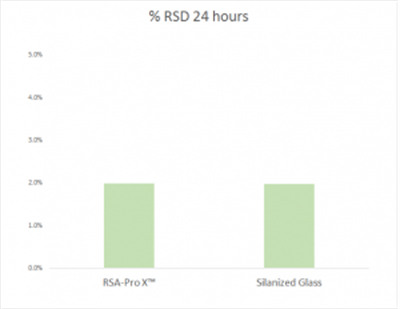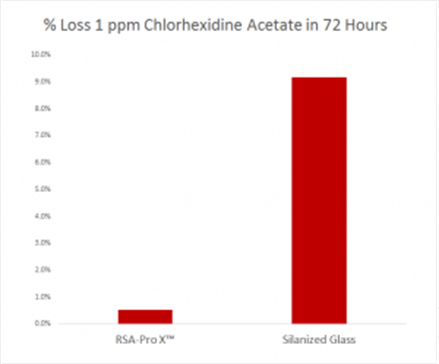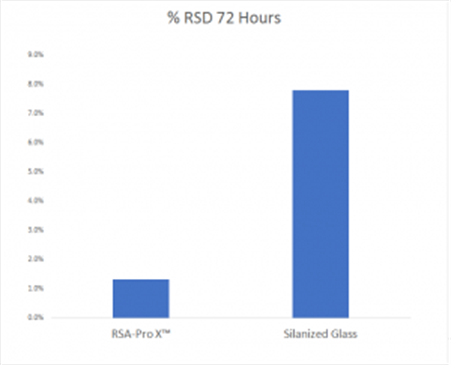Overview
RSA-Pro X™ vials and low-volume glass inserts are engineered for applications requiring high hydrophobicity and exceptional hydrolytic stability. These vials are specifically designed to address the limitations of conventional silanized glass, particularly in aqueous environments and with analytes prone to adsorption.
Background
Glass surfaces inherently contain silanol groups (Si–OH), which are known to interact with basic and polar analytes. These interactions can lead to:
- Quantitative loss of analyte
- Poor reproducibility (high %RSD)
- Vial-to-vial variability
- Time-dependent degradation of analytical performance
Silanized vials attempt to mitigate these effects by chemically modifying the glass surface. However, silanization is often incomplete, prone to delamination, and lacks long-term stability in aqueous matrices.
RSA-Pro X™ vials offer a robust alternative. Built on the RSA™ (Reduced Surface Activity) platform, RSA-Pro X™ vials feature a hydrophobic, surface-treated glass that maintains integrity even after prolonged exposure to water, autoclaving, or freezing.
Experimental Design
Objective:
To evaluate the quantitative stability and reproducibility of RSA-Pro X™ vials compared to conventional silanized glass vials over a 72-hour period in aqueous conditions.
Analyte:
Chlorhexidine acetate, 1 ppm in deionized water
Method Conditions:
- Column: Cogent RP C18™, 5 μm, 100 Å (Cat. No. 68518-15P)
- Dimensions: 4.6 × 150 mm
-
Mobile Phase: 55:45 acetonitrile / buffer (v/v)
- Buffer: 0.690 g sodium dihydrogen phosphate, 14.0 g sodium perchlorate, 0.340 mL phosphoric acid (50%) in 1 L DI water
- Injection Volume: 10 μL
- Flow Rate: 1.0 mL/min
- Detection: UV at 260 nm
- Sample Prep: 1 ppm chlorhexidine acetate in DI water, prepared in PPE bottle
Results Summary
-
24-Hour Exposure:
Minimal difference in %RSD between RSA-Pro X™ and silanized vials, indicating comparable short-term performance. -
72-Hour Exposure:
RSA-Pro X™ vials demonstrated:- Lower analyte loss over time
- Significantly improved reproducibility (%RSD)
- Superior surface stability in aqueous conditions



These results confirm that RSA-Pro X™ vials maintain surface integrity and analytical performance over extended periods, unlike conventional silanized vials which degrade in performance due to surface instability and incomplete silanol masking.
Conclusion
RSA-Pro X™ vials and inserts provide a reliable solution for applications involving:
- Aqueous sample matrices
- Hydrophilic or basic analytes
- Long-term sample storage
- High-sensitivity LC or LC-MS workflows
Their hydrophobic, hydrolytically stable surface ensures consistent quantitation, reduced analyte loss, and improved reproducibility—making them a superior alternative to traditional silanized glass.
Note: If you’ve experienced inconsistent surface coverage, loss of hydrophobicity, or performance degradation in silanized vials, RSA-Pro X™ technology offers a robust and validated upgrade.

